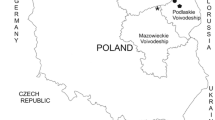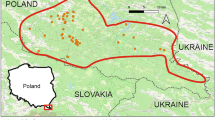Abstract
The effects of mineral deficiencies are often sub-clinical, and the importance of mineral status is often underestimated in wildlife populations. To our knowledge, this is the first study that gives reference intervals of hepatic minerals for Pyrenean chamois (Rupicapra pyrenaica). We determined macro and trace mineral concentrations in liver samples from 100 animals (44 healthy and 56 sick) collected in the Catalan Pyrenees (NE Spain) from 1995 to 2008. After wet digestion, we determined Na, K, Ca, P, Mg, S, and Fe concentrations by inductively coupled plasma optical emission spectrometry (ICP-OES) and Cu, Zn, and Mo concentrations by inductively coupled plasma mass spectrometry (ICP-MS). We observed low hepatic concentrations of Cu in a considerable percentage of chamois, without evidences that these low concentrations increased their susceptibility to infectious diseases. The group of sick chamois had very similar percentage of animals (10/56) with low concentration of Cu (<20 ppm DW) than the group of healthy chamois (9/44). On the other hand, we observed that infectious diseases increased significantly the hepatic concentrations of Na, Ca, Mg, Fe and Zn, very likely, as a consequence of processes associated with the acute phase inflammatory response. The obtained values of liver mineral levels and their sources of variation, such as sex, age and disease, mostly fall within the range of those described for other ruminants, but possible deficiencies and differences between individuals and populations require further study.


Similar content being viewed by others
References
Robbins CT (1993) Wildlife feeding and nutrition. Academic, New York
O’Hara T, Carroll G, Barboza P, Mueller K, Blake J, Woshner V, Wsicketto C (2001) Mineral and heavy metal status as related to a mortality event and poor recruitment in a moose population in Alaska. J Wildl Dis 37:509–522
Frank A, Danielsson R, Jones B (2000) The ‘mysterious’ disease in Swedish moose. Concentrations of trace elements in liver and kidneys and clinical chemistry. Comparison with experimental molybdenosis and copper deficiency in the goat. Sci Total Environ 249:107–122
Johnson HE, Bleich VC, Krausman PR (2007) Mineral deficiencies in tule elk, Owens Valley, California. J Wildl Dis 43:61–74
Sleeman JM, Magura K, Howell J, Rohm J, Murphy LA (2010) Hepatic mineral values of white-tailed deer (Odocoileus virginianus) from Virginia. J Wildl Dis 46:525–531
Underwood EJ, Suttle NF (1999) The mineral nutrition of livestock. CABI Publishing, Wallingford
Marco I, Lopez-Olvera JR, Rosel R, Vidal E, Hurtado A, Juste R, Pumarola M, Lavin S (2007) Severe outbreak of disease in the Southern chamois (Rupicapra pyrenaica) associated with border disease virus infection. Vet Microbiol 120:33–41
Crampe JP, Bon R, Gerard JF, Serrano E, Caens P, Florence E, Gonzalez G (2007) Site fidelity, migratory behaviour, and spatial organization of female isards (Rupicapra pyrenaica) in the Pyrenees National Park, France. Can J Zool 85:16–25
Lopez-Olvera JR, Marco I, Montané J, Lavin S (2006) Haematological and serum biochemical values of Southern chamois (Rupicapra pyrenaica). Vet Rec 158:479–484
Kincaid RL (2000) Assessment of trace mineral status of ruminants: a review. J Anim Sci 77:1–10
Plumlee KH (2003) Clinical veterinary toxicology. Mosby, St. Louis
National Research Council (NRC) (2005) Mineral tolerance of animals, 2nd edn. National Academy of Sciences, Washington DC
Maas J (2007) Diagnostic considerations for evaluating nutritional problems in cattle. Vet Clin N Am Food Anim Pract 23:527–539
Littledike ET, Wittum TE, Jenkins TG (1995) Effect of breed, intake, and carcass composition on the status of several macro and trace minerals of adult beef cattle. J Anim Sci 73:2113–2119
Falandysz J (1993) Some toxic and essential trace metals in cattle from the Northern part of Poland. Sci Total Environ 136:177–191
Miranda M, López-Alonso M, Castsicko C, Hernández J, Benedito JL (2005) Effects of moderate pollution on toxic and trace metal levels in calves from a polluted area of Northern Spain. Environ Int 31:543–548
Blanco-Penedo I, Cruz JM, López-Alonso M, Miranda M, Castsicko C, Hernández J, Benedito JL (2006) Influence of copper status on the accumulation of toxic and essential metals in cattle. Environ Int 32:901–906
López-Alonso M, Crespo A, Miranda M, Castsicko C, Hernández J, Benedito JL (2006) Assessment of some blood parameters as potential markers of hepatic copper accumulation in cattle. J Vet Diagn Invest 18:71–75
Sivertsen T, Plassen C (2004) Hepatic cobalt and copper levels in lambs in Norway. Acta Vet Scand 45:69–77
Egeland B, Fimreite N, Rosef O (2005) Liver element profiles of red deer with special reference to copper and biological implications. HiT Publications, Telemark University College, Porsgrunn
Vikoren T, Bernhoft A, Waaler T, Handeland K (2005) Liver concentrations of copper, cobalt, and selenium in wild Norwegian red deer (Cervus elaphus). J Wildl Dis 41:569–579
Zimmerman TJ, Jenks JA, Leslie DM, Neiger RD (2008) Hepatic minerals of white-tailed and mule deer in the Southern Black Hills, South Dakota. J Wildl Dis 44:341–350
Surai PF (2005) Mineral and anti-oxidants. In: Taylor-Pickard JA, Tucker LA (eds) Redefining mineral nutrition. Nottingham University Press, Nottingham, pp 147–177
Kaneko J, Harvey J, Bruss M (2008) Clinical biochemistry of domestic animals. Academic, San Diego
McClure SJ (2008) How minerals may influence the development and expression of immunity to endoparasites in livestock. Parasite Immunol 30:89–100
Salminen R, Batista MJ, Bidovec M et al (2005) Geochemical atlas of Europe, part 1: background information, methodology and maps. Geological Survey of Finland, Espoo
Peverill KI, Sparrow LA, Reuter DJ (2001) Soil analysis: an interpretation manual. CSIRO Publishing, Collingwood
Garcia-Pausas J, Casals P, Camarero L, Huguet C, Sebastià MT, Thompson R, Romanyà J (2007) Soil organic carbon storage in mountain grasslands of the Pyrenees: effects of climate and topography. Biochemistry 82:279–289
Datnoff LE, Elmer WH, Huber DM (2007) Mineral nutrition and plant disease. The American Phytopathological Society, St. Paul
Alvera B, García-González R (1988) Contenido de oligoelementos en plantas de pastos supraforestales pirenaicos en relación con el pastoreo de los rumiantes. In: Homenaje a Pedro Montserrat. Instituto de Estudios Altoaragoneses & Instituto Pirenaico de Ecología, pp 895–901
Howell JM, Gawthorne JM (1987) Copper in animals and man, vol 1. CRC Press, Boca Raton
Pott EB, Henry PR, Zanetti MA, Rao PV, Hinderberger EJ Jr, Ammerman CB (1999) Effects of high dietary molybdenum concentration and duration of feeding time on molybdenum and copper metabolism in sheep. Anim Feed SciTechnol 79:93–105
Miranda M, Cruz JM, López-Alonso M, Benedito JL (2006) Variations in liver and blood copper concentrations in young beef cattle raised in North-West Spain: associations with breed, sex, age and season. Anim Sci 82:253–258
Rombach EP, Barboza PS, Blake JE (2003) Costs of gestation in an arctic ruminant: copper reserves in muskoxen. Comp Biochem Physiol C Toxicol Pharmacol 134:157–168
Giacometti M, Janovsky M, Belloy L, Frey J (2002) Infectious keratoconjunctivitis of ibex, chamois and other caprinae. Rev Sci Tech OIE 21:335–345
Ilbäck NG, Glynn AW, Wikberg L, Netzel E, Lindh U (2004) Metallothionein is induced and trace element balance changed in target organs of a common viral infection. Toxicology 199:241–250
Ilbäck NG, Benyamin G, Lindh U, Friman G (2003) Sequential changes in Fe, Cu and Zn in target organs during early Coxsackievirus B3 infection in mice. Biol Trace Elem Res 91:111–123
Guilford WG, Center SA, Strombeck DR, Wsickiams DA, Meyer DJ (1996) Strombeck’s small animal gastroenterology. W.B. Saunders Company, Philadelphia
Ackermann D, Mordasini D, Cheval L, Imbert-Teboul M, Vogt B, Doucet A (2007) Sodium retention and ascites formation in a cholestatic mice model: role of aldosterone and mineralocorticoid receptor? Hepatology 46:173–179
Frost L, Mahoney J, Field J, Farrell GC (1996) Impaired bile flow and disordered hepatic calcium homeostasis are early features of halothane-induced liver injury in guinea pigs. Hepatology 23:80–86
Edvinsson M, Frisk P, Molin Y, Hjelm E, Ilback NG (2008) Trace element balance is changed in infected organs during acute Chlamydophila pneumoniae infection in mice. Biometals 21:229–237
Acknowledgments
The authors are very grateful to the rangers and staff from the Freser-Setcases, Alt Pallars-Aran and Cadí national game reserves, whom all provided invaluable help. We are also very grateful to Dr Gloria Lacort and the staff of the Scientific-Technical Services of the University of Barcelona for their assistance in the laboratory and above all, to our colleagues from the Servei d’Ecopatologia de Fauna Salvatge (SEFaS), who also collaborated with this study.
Conflict of Interest
The authors declare that they have no conflict of interest.
Author information
Authors and Affiliations
Corresponding author
Rights and permissions
About this article
Cite this article
Manent, J., Cuenca, R., López-Olvera, J.R. et al. Mineral Levels in Pyrenean Chamois (Rupicapra pyrenaica). Biol Trace Elem Res 157, 218–223 (2014). https://doi.org/10.1007/s12011-014-9894-x
Received:
Accepted:
Published:
Issue Date:
DOI: https://doi.org/10.1007/s12011-014-9894-x




